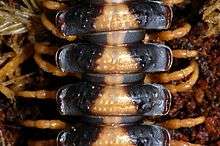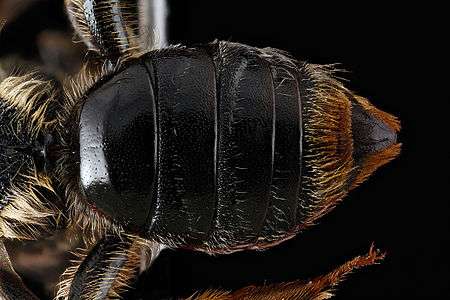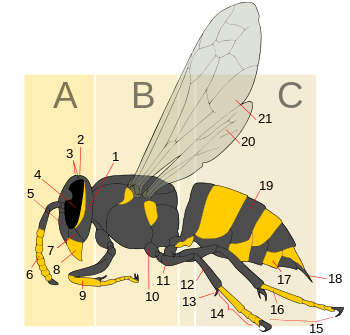Tergum

A tergum (Latin for "the back"; plural terga, associated adjective tergal) is the dorsal ('upper') portion of an arthropod segment other than the head. The anterior edge is called the base and posterior edge is called the apex or margin. A given tergum may be divided into hardened plates or sclerites commonly referred to as tergites.[1]:20 For a detailed explanation of the terminology, see [2] Kinorhynchs have tergal and sternal plates too, though seemingly not homologous with those of arthropods.[3]
So, for example, in a thoracic segment, the tergum may be divided into an anterior notum and a posterior scutellum. Lateral extensions of a tergite are known as paranota (Greek for "alongside the back") or carinae (Latin for "keel"), exemplified by the flat-backed millipedes of the order Polydesmida.
In crustaceans, the tergum is known as a pleuron when it overhangs the insertion of the limb on each side as a free plate.
In contrast to the tergum, the ventral portion of a segment is called the sternum.
Examples
 Abdominal tergum (divided into several tergites) of a bee.
Abdominal tergum (divided into several tergites) of a bee. Seven sclerites distinctly visible on the back of a pregnant scorpion.
Seven sclerites distinctly visible on the back of a pregnant scorpion. A tergite of this wasp is labeled 19.
A tergite of this wasp is labeled 19..png) Thoracic tergites of various trilobites.
Thoracic tergites of various trilobites.
Footnotes
- ↑ McCafferty (1983).
- ↑ Hood (1958). "THE TERMS TERGUM AND STERNUM, TERGITE AND STERNITE". doi:10.2307/2411977/2/7-3-131 (inactive 2018-09-23).
- ↑ Sørensen, M. V. et al. Phylogeny of Kinorhyncha based on morphology and two molecular loci. PLoS One 10, 1–33 (2015).
References
- McCafferty, W. Patrick (1983). Aquatic entomology: the fishermen's and ecologists' illustrated guide to insects and their relatives. Jones & Bartlett. Retrieved 8 Jan 2010 – via Google Books. ISBN 0-86720-017-0, ISBN 978-0-86720-017-1.